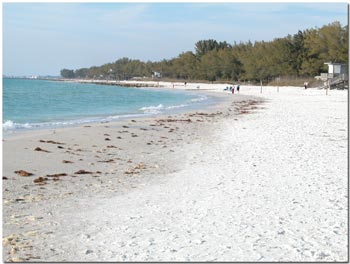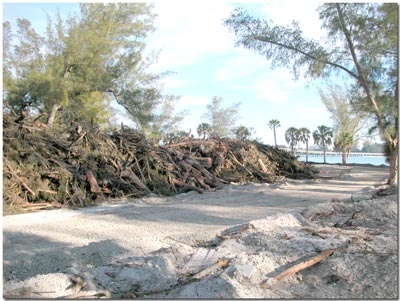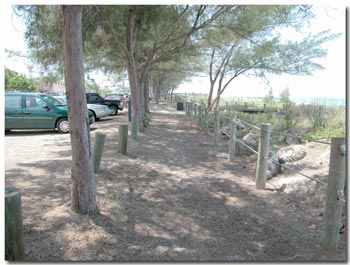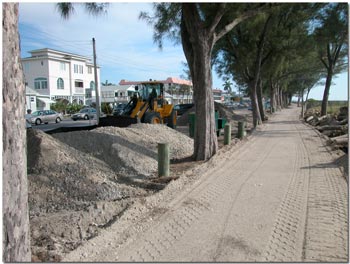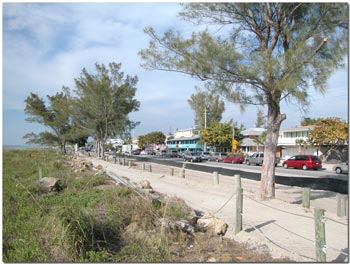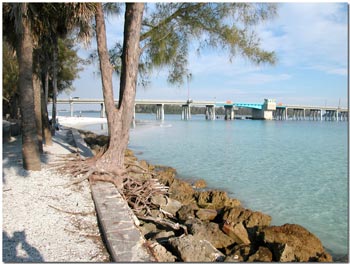Coquina Beach Trail | BeachHunter.net |
||||
Coquina Beach Trail Australian Pine DestructionI got an email from my friend Curtis Mcfee (Manatee County Lifeguard) in early February 2007 telling me about some changes happening at Coquina beach in the Bradenton, Florida area. He suggested I come down and have a look. The changes involve the creation of an 8 foot wide concrete walkway from the piers on Cortez beach to Longboat Pass, and eventually to extend underneath the Longboat Key bridge to the eastern shore of Coquina Beach (the bay side of the island). Removal of Australian Pines at Cortez and Coquina BeachesI decided to do some research before I drove down, just to get some background. Google research turned up a newspaper article in The Islander indicating that about 37 Australian pine trees (Casuarina equisetifolia L.) would be destroyed to accomplish the project. I know that without shade, a day at the beach in Florida can be a "broiling" experience, and Coquina beach has for decades been famous for its dense canopy of shade from the tall Australian pines between the parking area and the dunes.
As you can see from the photo (left)Australian pines dominate the landscape at Coquina Beach and provide shade for humans and shelter for animals. I have many happy memories of shady family picnics under these beautiful trees. Upon arriving at Cortez beach, I found that the heavy equipment was already working and that many trees had already been removed. I picked up a copy of the Anna Maria Island Sun and read the front page article by staff writer Tom Vaught titled "Tree-Cutting Prompts Outcry." It seems that 37 trees were originally marked for destruction because they were in the way of the new trail, but after they "looked at the plans more closely" (always a good idea), it was determined that 100 trees would have to go. After realizing that chopping down 100 shade trees seemed like too much, they finally settled on removing 66 trees. I don't know what the final tally is, but the pile of tree refuse was quite large (see photo below). The pile is at least eight feet high. The Longboat Key bridge can be seen in the photo (middle right).
The most obvious reduction in trees is in front of the piers along Cortez beach, where the fewest trees existed. There was a single line of trees between the parking area and the dunes. A walking trail already existed there, but was not paved. Below is a photo taken in May of 2002, showing the unpaved trail that I've walked many times over the years.
Further south at Coquina beach, the removal of trees isn't so obvious because there are so many growing in a dense stand. Below are a few photos of the new trail under construction.
In the above photo taken at Longboat Pass in February 2007 you can see one of the pines growing right on the sea wall, roots exposed. Looks like it's on it's last legs doesn't it? Now look at the initials carved into the trunk. Note the date: 1967! It's been there a long time. I was only 7 years old in 1967. Where is Cortez Beach and Coquina Beach?
Overall, the character of the beach hasn't been disturbed because of the new trail. But the cutting down of trees to make way for "progress" is always a hot topic, and gives rise to a larger question, about which I often receive emails. Should ALL Australian pines be removed? Or do they sometimes have enough value to save? The State of Florida has classified the Australian pine as an exotic and invasive species and has an ongoing program to eradicate the trees in Florida Parks (including beach parks). The main complaint I hear is that without the trees, there is no shade. Many people also like the wispy and graceful appearance of tall pines and the gnarled interesting shape of the trunk and roots of some of the old pines. BeachHunter's OpinionI think the trail will have a positive effect overall on the usability of the beach park, but only slightly. Somehow, in my mind, the nearly $400,000 being spent on the new "trail" would have been MUCH better spent upgrading the sorry excuse for restrooms that has been the norm at Coquina beach for at least the last four decades. I'd rather pee in the bushes, thank you. Australian Pine Eradication in FloridaI'm not going to debate the issue here, but you can read about the Australian Pine destruction issue at Ken Ellis' website in the Boca Raton area. For facts about the Australian pine, you can refer to the Plant Conservation Alliance's Alien Plant Working Group. Here is another good, easy to read article on Australian Pines. The powers that be are SERIOUS about taking out the Australian pines. Below is a photo of Stump Pass State Park (Englewood, FL) taken several years ago. Note the dead, but mostly still upright, Australian pines which were killed by herbicide as part of the exotic species eradication program.
There are valid arguments for and against destruction of some or all of Florida's Australian pines. In any case, careful thought should be given to the effects on all things, human and non-human, before removing trees. Such destruction, in some cases, seems unnecessary. --BeachHunter |
